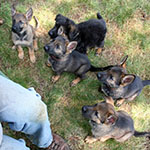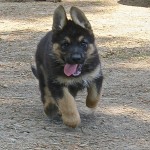Welcome To Candle Hill Shepherds!
WE HAVE PUPPIES !
Home of Von Hoffnung “of hope” German Shepherds. Long Coat and Standard Coated Puppies. Our dogs are the old line German Shepherds of carefully selected bloodlines: DDR (East German), Czech and Slovak, as well as old world West German bloodlines, bred for work, security, and companionship. We want sensible yet Happy dogs, gentle around children and pets, friendly to guests. Yet dogs with the courage to offer security to our family and to handle work with confidence: intelligent, loyal, lovable, Happy, legendary–the sort of dog many of us grew up only dreaming about.
Our dogs are chosen not only for our personal security, but also for our own work in Search and Rescue, Schutzhund, Obedience Competition, and Agility. Because we work our dogs, we know our dogs. The German Shepherd, known for its protective instinct, is one of the more versatile breeds, being able to perform in Therapy, Herding, as well as Security. Our bloodlines include the best of European lines. We produce huggable long coated (or long haired) German Shepherds as well as standard coated shepherds. We look for intelligent focus with a tireless work ethic. We treasure their ability to bond and cultivate this in our puppies.
Our selection of animals for breeding is quite rigid. We have researched our dog’s pedigrees for health, especially making sure hips and elbows have been x-rayed and certified as dysplasia free over the generations, as well as all breeding pairs being DM (Degenerative Myelopathy) clear. We’ve been breeding German Shepherds for over 20 years now so we know the health several generations back to our original breeding pairs. When we purchase an unrelated dog, we look into the health of that line before introducing it to our program. After certifying their health, we consider the temperament of the dogs. Only dogs that have nice balance proven through work are considered. With the health and temperament of the parents in good order, the other key to the success of our program is our neonatal puppy care. We begin from birth with a biosensory stimulation program, followed by a puppy enrichment plan similar to that of the Monks of New Skete. We are firm believers that the care given these pups during the early weeks of their life and thereafter is key to assuring sound, balanced adult dogs later in life.
Be sure to talk to us about your ideal dog and the characteristics important to you. Based on our knowledge of the parents and their bloodlines we will match you first to the litter which best suits you, then to the pup out of that litter which will best fit your lifestyle. Let us know the level of security you desire and in what field of work you wish to train your dog and we will make every effort to match you with a puppy of temperament appropriate to that field be it Police work, Schutzhund, or Personal Protection, to Personal Companion, Service Dogs, AKC Obedience, Agility, or Search and Rescue.
Feel free to contact us with any questions. Talking about our dogs or training ideas is something we are happy to do.
Our Breeding Program Is Based on 3 Things
Proven Health | Proven Temperament | Puppy Enrichment |
Last Updated: March 28, 2025












